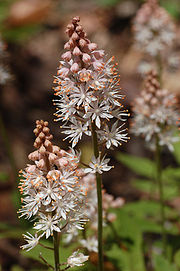
Mt. Cuba Center
Encyclopedia

Botanical garden
A botanical garden The terms botanic and botanical, and garden or gardens are used more-or-less interchangeably, although the word botanic is generally reserved for the earlier, more traditional gardens. is a well-tended area displaying a wide range of plants labelled with their botanical names...
and historical preserve located on Barley Mill Road in Greenville, Delaware
Greenville, Delaware
Greenville is a census-designated place in New Castle County, Delaware, United States. The population was 2,326 at the 2010 census.-Geography:Greenville is located at ....
, near Wilmington
Wilmington, Delaware
Wilmington is the largest city in the state of Delaware, United States, and is located at the confluence of the Christina River and Brandywine Creek, near where the Christina flows into the Delaware River. It is the county seat of New Castle County and one of the major cities in the Delaware Valley...
, USA
United States
The United States of America is a federal constitutional republic comprising fifty states and a federal district...
in the gently rolling hills of the Delaware Piedmont. It preserves rural pastures and fields, protects local forests, and includes various woodland wildflower gardens and formal landscapes, and its woodland gardens produce some of the most spectacular displays of wildflowers in the mid-Atlantic region. The Center is open to the public for a fee, but admission must be arranged in advance.
Gardens
Mt. Cuba's well-documented plant collection is focused on the study of Delaware Piedmont flora, with well over 4,600 accessions representing more than 1,800 taxa, of which roughly 75% are of Piedmont origin. Horticultural research focuses on CimicifugaCimicifuga
Cimicifuga is a genus of between 12-18 species of flowering plants belonging to the family Ranunculaceae, native to temperate regions of the Northern Hemisphere....
, Cypripedium
Cypripedium
Cypripedium is a genus of 47 species of lady's-slipper orchids native to temperate and colder regions of the Northern Hemisphere.Some grow in the tundra in Alaska and Siberia, which is an unusually cold habitat for orchids. They can withstand extreme cold, growing under the snow and blooming when...
, Helonias, Hepatica
Hepatica
Hepatica is a genus of herbaceous perennials in the buttercup family, native to central and northern Europe, Asia and eastern North America...
, Hexastylis
Hexastylis
Hexastylis or heartleaf is a segregate of the genus Asarum, in the family Aristolochiaceae. The group comprises ten species endemic to southeastern North America. It is a perennial, evergreen, herbaceous plant with leaves and flowers arising directly from the rhizomes...
, Stewartia and Trillium
Trillium
Trillium is a genus of about 40–50 species of spring ephemeral perennials, native to temperate regions of North America and Asia....
, and Mt. Cuba Center is a "national collection" holder for Hexastylis
Hexastylis
Hexastylis or heartleaf is a segregate of the genus Asarum, in the family Aristolochiaceae. The group comprises ten species endemic to southeastern North America. It is a perennial, evergreen, herbaceous plant with leaves and flowers arising directly from the rhizomes...
and Trillium
Trillium
Trillium is a genus of about 40–50 species of spring ephemeral perennials, native to temperate regions of North America and Asia....
. Several of its introductions are widely popular, including Aster laevis 'Bluebird', Aster novae-angliae 'Purple Dome' and Solidago sphacelata 'Golden Fleece'.
The Center encompasses a diverse set of grounds, ranging from a formal Lilac Path, Round Garden, and South Terrace to more natural gardens including the Dogwood Path, Meadow, Pond Garden, West Slope Path, and Woods Path.
History
Mt. Cuba started as the vision of the late Mr. and Mrs. Lammot du Pont Copeland, who began acquiring land near Wilmington, Delaware in 1935, and completed construction of their Colonial Revival house in 1937. During the late 1930s, formal areas were designed first by the prominent Philadelphia landscape architect Thomas W. Sears and later, in the 1950s, by noted landscape designer Marian C. Coffin.The naturalistic gardens were developed 1965-1971 under the design of Seth Kelsey, a Harvard trained landscape architect from Massachusetts, to feature native trees, shrubs, and native wildflowers. In the early 1980s, with input from director Dr. Richard W. Lighty, the Copelands expanded their gardening to encompass the entire Piedmont region. After Mr. Copeland's death in 1983, Mrs. Copeland continued garden development and refinement. Mrs. Copeland died in 2001, and the Center has since continued as a non-profit organization and a member of the American Public Gardens Association
American Public Gardens Association
The American Public Gardens Association is an association of public-garden institutions and professionals primarily in the United States and Canada....
.
See also
- Mount Cuba Astronomical ObservatoryMount Cuba Astronomical ObservatoryMount Cuba Astronomical Observatory is an astronomical observatory is located in Greenville, Delaware, USA. This observatory is home to a 0.6-meter telescope used by the Delaware Astronomical Society, the University of Delaware, and the Whole Earth Telescope....
- List of botanical gardens in the United States
- North American Plant Collections ConsortiumNorth American Plant Collections ConsortiumThe North American Plant Collections Consortium is a group of North American botanical gardens and arboreta that aims to improve the continent's living plant collections, and enhance the availability of plant germplasm...

